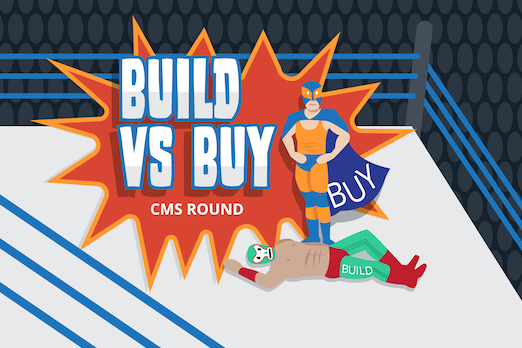How Headless CMS Is Killing the Buy vs Build Decision

By 2030, each person is expected to use as many as 15 different internet-enabled devices regularly. Even today, 90 percent of consumers use more than one device to pursue a single objective online.
Then there’s the78 percent of people who are more likely to make a purchase from a brand that serves them a relevant content experience—and the 50 percent who would even pay more for it.
Tell me, what is your expensive, custom-built CMS doing to help your company keep up with the rapidly growing demand for personalized, optimized, multichannel content?
If the answer is “not enough,” we’ve heard that before. Keep reading to learn why that’s happening and what every company that publishes content can do to remain relevant.
The Evolution from Custom CMS to Headless CMS

A custom CMS is what it sounds like—a proprietary solution that a company has created to exactly fit their needs. Because they’re built for such specific use cases, custom CMS platforms are usually coupled. That means the functionality on the backend and the display on the front end are “coupled” into an all-in-one solution. WordPress is a popular coupled, also known as “traditional,” CMS.
Once considered the standard among media brands and other businesses that needed to publish lots of static content, today the coupled approach doesn’t stand up to current requirements for ease of use, fast and affordable scaling, and omnichannel content distribution.
It’s in this gap between the rigidity of traditional CMS and the personalized content that today’s always-on consumers crave where headless CMS sprung up. And it’s all but squashed the argument between buying and building s content management system.
After all, why go for the more expensive and slower-moving custom CMS when right now there’s a whole new category of CMS platforms that are built to be completely customizable to your own needs both now and ten years down the line?
With headless CMS; content storage, creation, and display all function separately from each other. It’s essentially a content repository from which developers can call content as a service via application programming interfaces (APIs).
This model-view-controller (MVC) model decouples the core framework (model), its presentation (view), and the functionality (controller) to make it much safer and faster to update, reconfigure, and grow each part without negatively impacting the others.
Decoupling the content from the way it’s ultimate displayed allows front-end developers to implement the best tech for any distribution scenario and marketers to build pages and create content without IT support.
What the CMS Shift Means for Media (and Other Big Publishers)
No matter how unique their content or audience, fundamentally, most businesses are looking for the same thing—a way to distribute all that awesome content to that equally awesome audience reliably, affordably, and sustainably.
Once upon a time, the only way a big-time publisher could check all three of those boxes was to have their own custom CMS solution built for them.
But now, everyone from leading media companies to professional sports teams can use the same headless CMS platform just as easily as they can use the same CRM or email marketing platform. No matter how wildly different their content and audience and distribution channels are, the decoupled nature of a headless CMS makes it simple for content creators of all walks to do what they do best while development pulls in third-party apps (like Apple News, Google AMP, and more) and builds the just-right display for a variety of channels and experiences.
Just ask Jesse Knight, former CTO at the international media company Vice:
“Today, though, the commercial market for publishing platforms is maturing, and ‘buy’ is finally becoming a viable option,” Knight said. “I don’t suggest ‘buy’ casually, as I spent more than seven years building an international-first platform for Vice that was best in class. It spanned more than 12 brands and was used by offices in 35 countries. But the rationale I used for building rather than buying 10 years ago was predicated on a user experience and platform market that is dramatically different in 2018.”
So, like it has done so many times before, it’s time for the media industry—and everyone else who’s creating content experiences—to adopt the headless CMS architecture that will launch them into the future.
The Future of Content Lies in Headless Architecture
It wasn’t that long ago when everything from the news to corporate websites existed on static, server-based web pages. But just as the world has changed since those days, so has technology evolved to include rich online experiences.
The era of the static, custom CMS is drawing to a close.
Consumer demand calls for robust and flexible content publishing, so businesses are un-coupling their content from their design to make it seamless available across every channel and device. What rules in digital media today is a microservice approach where a myriad of services work together via API connections—the same way headless CMS can be configured to deliver content as a service via API.
Sure, it's unlikely that the custom-built, traditional CMS will fade into complete obscurity. Honestly, it’ll always be a solution for quick and basic websites. However, for the most part, today’s world calls for much more from businesses—especially fast-paced, media-focused ones—which means they demand much more from their content management systems.
About Contentstack
The Contentstack team comprises highly skilled professionals specializing in product marketing, customer acquisition and retention, and digital marketing strategy. With extensive experience holding senior positions at renowned technology companies across Fortune 500, mid-size, and start-up sectors, our team offers impactful solutions based on diverse backgrounds and extensive industry knowledge.
Contentstack is on a mission to deliver the world’s best digital experiences through a fusion of cutting-edge content management, customer data, personalization, and AI technology. Iconic brands, such as AirFrance KLM, ASICS, Burberry, Mattel, Mitsubishi, and Walmart, depend on the platform to rise above the noise in today's crowded digital markets and gain their competitive edge.
In January 2025, Contentstack proudly secured its first-ever position as a Visionary in the 2025 Gartner® Magic Quadrant™ for Digital Experience Platforms (DXP). Further solidifying its prominent standing, Contentstack was recognized as a Leader in the Forrester Research, Inc. March 2025 report, “The Forrester Wave™: Content Management Systems (CMS), Q1 2025.” Contentstack was the only pure headless provider named as a Leader in the report, which evaluated 13 top CMS providers on 19 criteria for current offering and strategy.
Follow Contentstack on LinkedIn.






.svg?format=pjpg&auto=webp)
.svg?format=pjpg&auto=webp)
.png?format=pjpg&auto=webp)






.png?format=pjpg&auto=webp)




